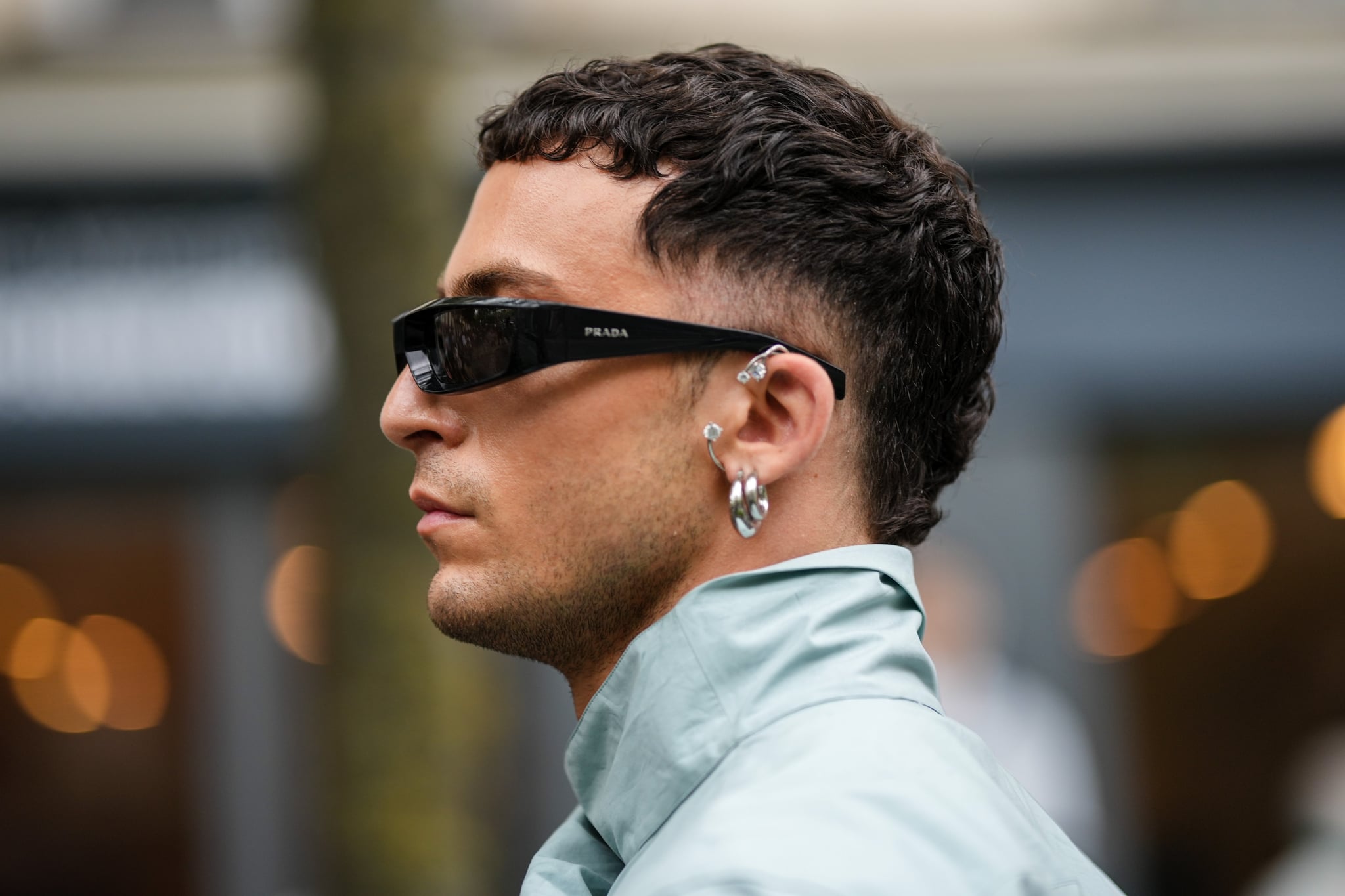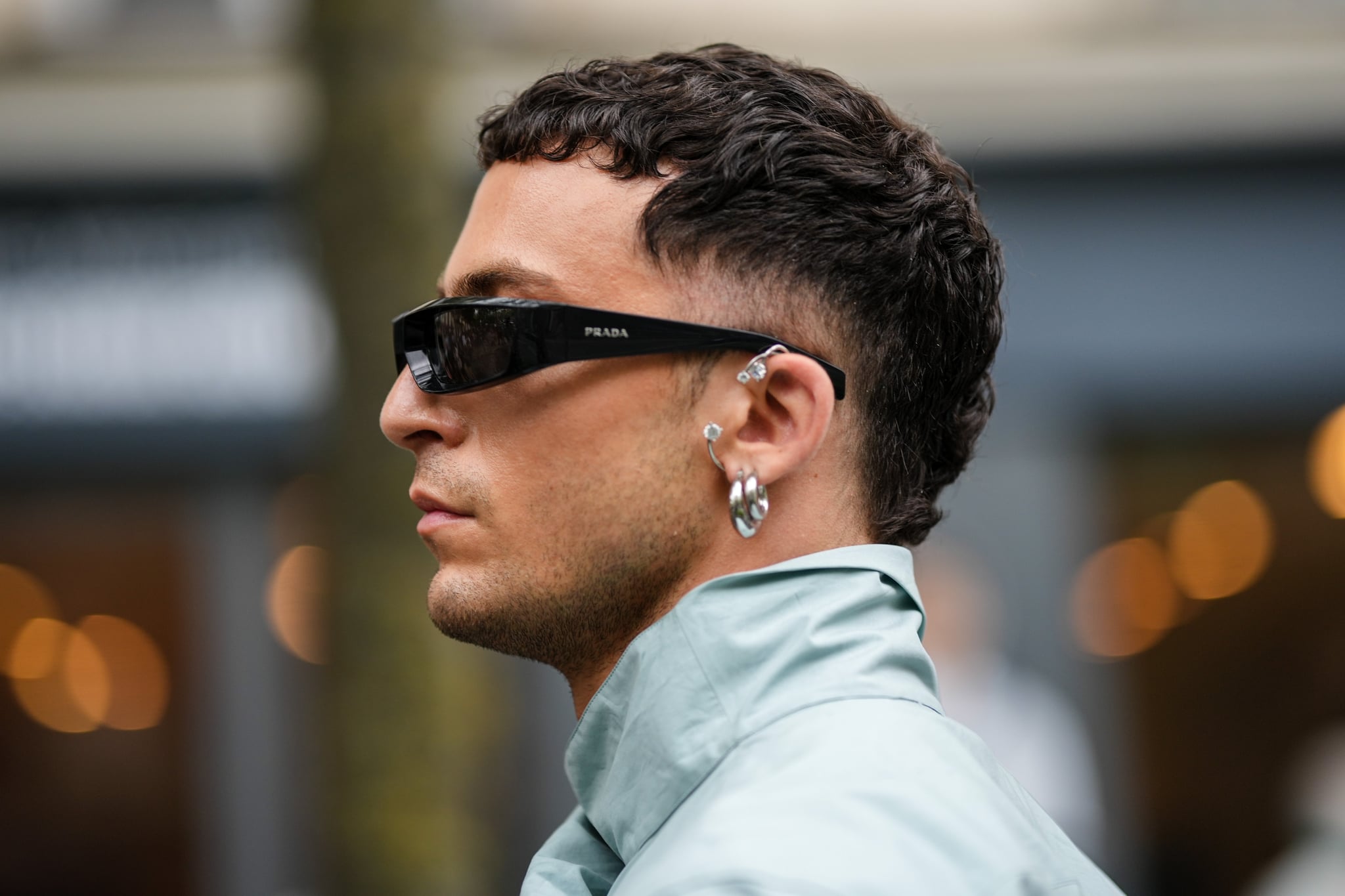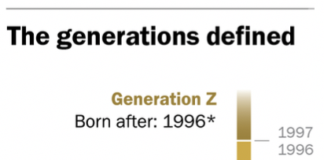
Image Source: Getty / Edward Berthelot
Seldom does a trend these days stick around for longer than a few weeks before a neologism replaces the one before it, permeating the halls of TikTok or Instagram and causing all of us to second guess what was once considered mainstream — only to then swap a coveted wardrobe staple for the latest passing fad.
Still, certain exceptions prevail. Even today, one of the most unshakeable cultural signifiers has been the “mono” piercing — more preciously, and befuddling, on which ear it’s placed and what it says about your sexuality. Pre-Y2K (and beyond), it’s been socially understood that wearing one earring on the right ear means someone is gay; the left, straight. Despite recent data and celebrities supporting otherwise, the demagogic proverb “Left is right and right is wrong” has been a whisper placed upon gay and straight men (and their piercers) for decades. No one really seems to know where the adage originated. Or which side means what. It is, however, a uniquely American conundrum.
Lyst, a company that tracks online shoppers’ behavior, claims searches for men’s earrings are up by 147 percent since last year (see: Lil Nas X, Jared Leto, Harry Styles, Bad Bunny). No longer is it that big of a deal that a cisgender, occasionally heterosexual man wears jewelry — not even those flashy beaded bracelets. It was once even more vogue, and still is, to have multiple piercings in one ear. Yet further findings, like the fact that “mono earring” queries are popular, suggest many are curious about specifically embellishing one ear only — proof that a single earring, and which lobe it lives on, can say everything or nothing at all.
The concept of men wearing jewelry is an old one, dating back thousands of years. In fact, most royals were adorned in as many gems and as much gold as women — if not more, depending on the occasion — making the sight of guys wearing pearls today, for instance, more a reflection of where we’ve come from than where we’re headed. But the whole “gay ear” thing has always been ironic, considering its ever-changing position throughout history. It’s true, though, that “dropping a hairpin” — the precursor to signaling (a way to drop a subtle hint to someone that you, too, were gay) — was both harmful and helpful. During the Stonewall era, there weren’t any protections for LGBTQ+ people, so signaling could out someone depending on their whereabouts. Yet it helped earlier generations of queer people find each other in the crowd.

Image Source: Getty / Jeff Kravitz
A 1991 article in The New York Times perpetuating the stereotype seemed to solidify the historical hearsay as the widely known style taboo many can’t quit today. See also, very famous mono-earring wearers, between then and now: Harrison Ford, Michael Jordan, Mr. Clean, etc. And in the “Café Disco” episode of “The Office,” Kelly can be seen piercing Andy in a cutaway as he asks: “Are you sure that’s not the gay ear?”
But in the book “Sexuality and Gender in Postcommunist Eastern Europe and Russia,” editors Edmond J. Coleman and Theo Sandfort discuss the fact that straight Russian men would often mark their first sexual act with women by piercing their right ear as a way to ward off unwanted advances from gay men. And according to ancient Chinese belief, the wearing of an earring on the left ear also symbolized that a person’s life had been endangered, and to prevent a recurrence, an earring was worn to prevent bad luck. (China has since banned men’s earrings outright.)
Casting director and industry stalwart James Scully remembers his first encounter with the phenomenon, in the late ’70s. “As we were driving, my mother and aunt were staring at this man out of the window, slowing the car down, almost acting like he was some sort of creature because his right ear was pierced,” he recalls. Any piercing during that time, Scully insists, would have been an act of defiance anyway — pre- or postpunk era. “In college, Phil Oakey (The Human League) had both of his ears pierced, which really threw people for a loop because he was straight despite giving off the gayest vibe in the world.”
Eyebrows, noses, tongues, nipples, and belly buttons would soon become even louder ways to make a statement. On current rotation, Scully posits, is the septum piercing: equal parts rejection and an invitation, rooted in pleasure and pain. “Nowadays, everyone is too influenced. A lot of people don’t know why they’re dressed the way they are. What I think is missing with this generation is that no one has enough context. When I see someone who is pierced and I find it sexy or threatening, or it’s an obvious part of a more distinct and total look, I get it. But when Harry Styles does it . . . “
It’s a hot take on a generation who don’t really need an ear piercing to talk for them, who weren’t similarly reared on fashion as a conduit to freedom. In other words, if you walk up to a young adult on the street and ask them who they are, they’ll probably just tell you. A study conducted by the advertising insights agency Bigeye revealed that 51 percent of Gen Z agree that traditional gender roles and binary gender labels are outdated, with 56 percent of millennials believing the same. Some people, however, continue to rewrite the rules, using style as a way to reclaim lost time when flamboyance and exuberance were frowned upon and conformity (or passing) was the only way to get by.
“I wear [an earring] specifically on my right ear because I’m a proud queer person and I want the history of what it means to have your right ear pierced to be a symbol of power, not weirdness or mystery.”
Phillip Salem, a real estate agent and longtime New Yorker, has lived in a bubble for 15 years. That is, one of the three major US cities where different walks of life are more widely tolerated than, say, his hometown of Akron, OH. He rocks the “gay earring” on the regular — and on purpose, a signature style cue he refers to as his “gag du jour” on Instagram — rarely opting for a subtle hint of gold but a more-is-more approach. His most recent acquisition, a vintage Céline door knocker, could be seen from down the block. And he prefers it that way.
“I wear it specifically on my right ear because I’m a proud queer person and I want the history of what it means to have your right ear pierced to be a symbol of power, not weirdness or mystery,” he says, adding that it gives off a sense of community and safety, too. “This world is so f*cked up; any sense of comfort in the form of subliminal messaging or outward expression for LGBTQIA+ people goes a long way when it comes to feeling seen.”
Recent cultural forecasts are spot on with their predictions, too. The slow-burn comeback of the awkward noughties (frosted everything), indie sleaze, and party girls (ahem, white eyeliner) are no longer nostalgic, cringeworthy memories but legitimate demi-decades when our appearance was (still) an act of subversion. Today’s isms, like no-makeup makeup and tantouring, don’t force us to relive the best of the worst; rather, they remind us that the journey of defining a “personal” style is as finite as doing the dishes: you’re never really done.
For Salem, the “gay ear piercing” is a smaller yet crucial part of a bigger picture. And, though influential, he doesn’t expect designers like Kim Jones of Dior or Alessandro Michele at Gucci to push the rest of the world over the edge. If the mono earring has always been a conversation starter, then we have to address other ways style has elicited controversy, too. Despite trends becoming more fluid — the gap between gender-neutral styles in fashion and beauty narrowing — Salem knows the journey endures.
“I find it hilarious when people say, ‘Why can’t people just dress like their own gender and stop pushing their agenda on everyone?’ Because I can only say the same to so many other people for trying to tell me how to dress my entire life,” he says. Salem now boasts five ear piercings in total.
So, what is to be made — in 2022 — of being told what to wear where? Maybe the right ear versus the left ear was less about sexuality than it was about attitude. Nor was it about a limp wrist or gaydar. That queer people use fashion and beauty as armor or a way to communicate is not a new concept. That our sexuality, or how sexual we are in general, can be tied to style is what’s always going to keep fashion interesting.
That is Gen Z at its best: challenging the status quo, releasing age-old narratives, and shutting the door behind them. Because, as the studies show, it won’t matter to a new youth who harnesses their power in being different anyway.








